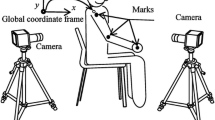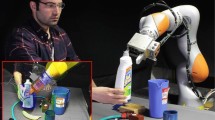Abstract.
Opening a door, turning a steering wheel, and rotating a coffee mill are typical examples of human movements that are constrained by the physical environment. The constraints decrease the mobility of the human arm and lead to redundancy in the distribution of actuator forces (either joint torques or muscle forces). Due to this actuator redundancy, there is an infinite number of ways to form a specific arm trajectory. However, humans form trajectories in a unique way. How do humans resolve the redundancy of the constrained motions and specify the hand trajectory? To investigate this problem, we examine human arm movements in a crank-rotation task. To explain the trajectory formation in constrained point-to-point motions, we propose a combined criterion minimizing the hand contact force change and the actuating force change over the course of movement. Our experiments show a close matching between predicted and experimental data.
Similar content being viewed by others
References
Abend W, Bizzi E, Morasso P (1982) Human arm trajectory formation. Brain 105:331–348
Baillieul J, Martin DP (1990) Resolution of kinematic redundancy. In: Brockett R (ed) Robotics Proceedings of the Symposia in Applied Mathematics, American Mathematical Society, 41:49–90
Bernstein N (1967) The coordination and regulation of movements. Pergamon, London
Chandler RF, Clause CE, McConville JT, Reynolds HM, Young JW (1975) Investigation of inertial properties of the human body, vol AMRL-TR-74-137. Wright Patterson Air Force Base, Ohio
Chung W, Oh Y, Park J, Nenchev DN (1999) Analysis and control of kinematically redundant manipulators. In: Tutorial TS3, IEEE/RSJ International conference on intelligent robots and systems, Kyongju, South Korea
Dornay M, Uno Y, Kawato M, Suzuki R (1996) Minimum muscle-tension change trajectories predicted by using a 17-muscle model of the monkey’s arm. J Motor Behav 28(2):83–100
Flash T, Hogan N (1985) The coordination of arm movement: a confirmed mathematical model. J Neurosci 5:1688–1703
Flash T, Hogan N, Richardson MJE (2003) Optimization principles in motor control. In: Arbib M (ed) Handbook of brain theory and neural networks, 2nd edn. MIT Press, Cambridge, MA, pp 827–831
Gomi H, Osu R (1998) Task-dependent viscoelasticity of human multijoint arm and its spatial characteristics for interaction with environments. J Neurosci 18(21):8965–8978
Harris CM (1998) On the optimal control of behaviour: a stochastic perspective. J Neurosci Meth 83:73–88
Harris CM, Wolpert DW (1998) Signal-dependent noise determines motor planning. Nature 394:780–784
Hoff B, Arbib MA (1992) A model of the effects of speed, accuracy, and perturbation on visually guided reaching. Exp Brain Res 22:285–306
Ito K, Tsuji K, Sugino M (1991) Impedance regulation in human movements during a rotation task. J Robot Mechatron pp 44–51
Jordan MI, Flash T, Arnon Y (1994) A model of the learning of arm trajectories from spatial deviations. J Cogn Neurosci 6:359–376
Kashima T, Isurugi Y (1998) Trajectory formation based on physiological characteristics of skeletal muscles. Biol Cybern 78:413–422
Kashima T, Isurugi Y, Shima M (2000) Analysis of a muscular control system in human movements. Biol Cybern 82:123–131
Kawato M (1996) Trajectory formation in arm movements: Minimization principles and procedures. In: Zelaznik H (ed) Advances in motor learning and control. Human Kinetics, Champaign, IL, pp 225–259
Kawato M (1999) Internal models for motor control and trajectory planning. Curr Opin Neurobiol 9:718–727
Kawato M, Maeda Y, Uno Y, Suzuki R (1990) Trajectory formation of arm movement by cascade neural network model based on minimum torque-change criterion. Biol Cybern 62:275–288
Kitazawa S (2002) Optimization of goal-directed movements in the cerebellum: a random walk hypothesis. Neurosci Res 43(4):289–294
Luo ZW, Yamakita M, Iwakoshi K, Ito M (1995) Compliance control considering robot’s manipulability. Trans Soc Instrum Contr Eng 31:1534–1536
Maeda H, Miyaji K (1994) Task understanding of the crank turning. In: IEEE/RSJ conference on intelligent robots and systems, 2:958–965
Mason M (1981) Compliance and force control for computer-controlled manipulators. IEEE Trans Syst Man Cybern 11(6):418–432
Meek SG, Wood JE, Jacobsen SC (1990) Model-based, multi-muscle EMG control of upper-extremity Prostheses. In: Winters JM, Woo SL-Y (eds) Multiple muscle system: biomechanics and movement organization. Springer, Berlin Heidelberg New York, pp 360–376
Morasso P (1981) Spatial control of arm movements. Exp Brain Res 42:223–227
Nijhof EJ, Kouwenhoven E (2000) Simulation of Multijoint arm Movements. In: Winters JM, Crago PE (eds) Biomechanics and neural control of posture and movement. Springer, Berlin Heidelberg New York, pp 363–372
Ohta K, Svinin MM, Luo ZW, Hosoe S (2003) Dealing with constraints: Optimal trajectories of the constrained human arm movements. In: Proceedings of the XVII IMEKO world congress, tc-18: measurement in human functions, Dubrovnik, Croatia, pp 2059–2064
Russell D, Hogan N (1989) Dealing with constraints: A biomechanical approach. In: Proceedings of the IEEE Engineering in Medicine and Biological Society 11th Annual Conference, pp 892–893
Scheidt R, Dingwell J, Mussa-Ivaldi F (2001) Learning to move amid uncertainty. J Neurophysiol 86:971–985
Schwartz A, Polak E, Chen Y (1997) RIOTS95: A matlab toolbox for solving optimal control problems, version 1.0, User Manual, Stanford University
Shadmehr R, Mussa-Ivaldi F (1994) Adaptive representation of dynamics during learning of a motor task. J Neurosci 14:3208–3224
Svinin MM, Ohta K, Luo ZW, Hosoe S (2001) Mathematical analysis of the crank turning task. In: International symposium on measurement, analysis and modeling of human functions (ISHF 2001), Sapporo, pp 346–352
Thoroughman KA, Shadmehr R (2000) Learning of action through adaptive combination of motor primitives. Nature 407:742–747
Todorov E, Jordan M (2002) Optimal feedback control as a theory of motor coordination. Nat Neurosci 5:1226–1235
Todorov E, Jordan MI (2003) A minimal intervention principle for coordinated movement. In: Becker S, Thrun S, Obermayer K (eds) Advances in neural information processing systems, vol 15. MIT Press, Cambridge, MA, pp 27–34
Uno Y, Kawato M, Suzuki R (1989) Formation and control of optimal trajectory in human multijoint arm movement. Biol Cybern 61:89–101
Uno M, Suzuki R, Kawato M (1989) Minimum muscle tension change model which produces human arm movement. In: Proceedings of the 4th symposium on biological and physiological engineering, pp 299–302
Wolpert DM, Ghahramani Z, Jordan MI (1995) Are arm trajectories planned in kinematic or dynamic coordinate? An adaptation study. Exp Brain Res 103:460–470
Zefran M (1996) Continuous methods for motion planning. PhD thesis, University of Pennsylvania
Author information
Authors and Affiliations
Corresponding author
Rights and permissions
About this article
Cite this article
Ohta, K., Svinin, M., Luo, Z. et al. Optimal trajectory formation of constrained human arm reaching movements. Biol. Cybern. 91, 23–36 (2004). https://doi.org/10.1007/s00422-004-0491-5
Received:
Accepted:
Published:
Issue Date:
DOI: https://doi.org/10.1007/s00422-004-0491-5





